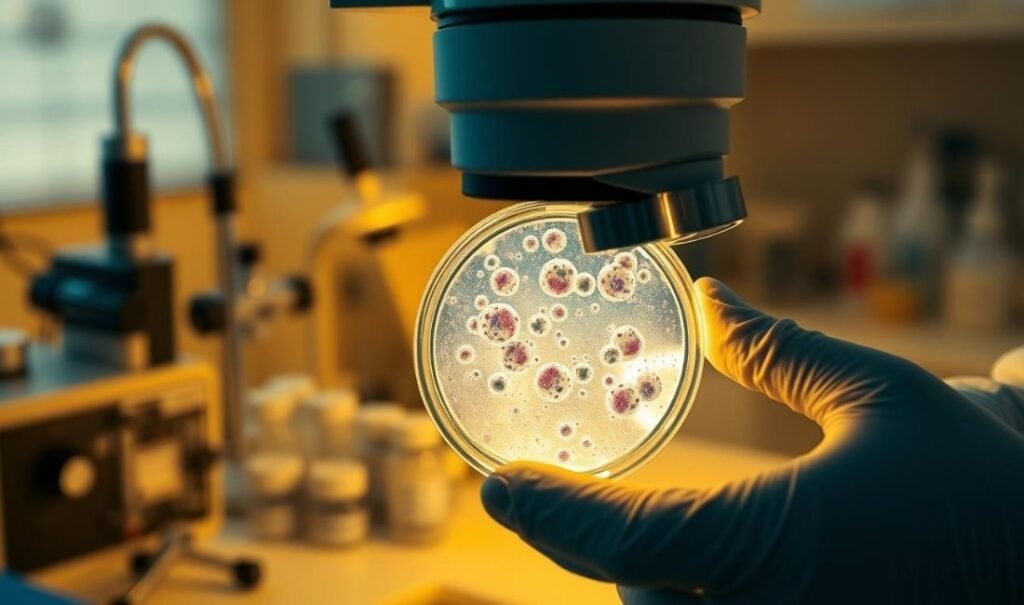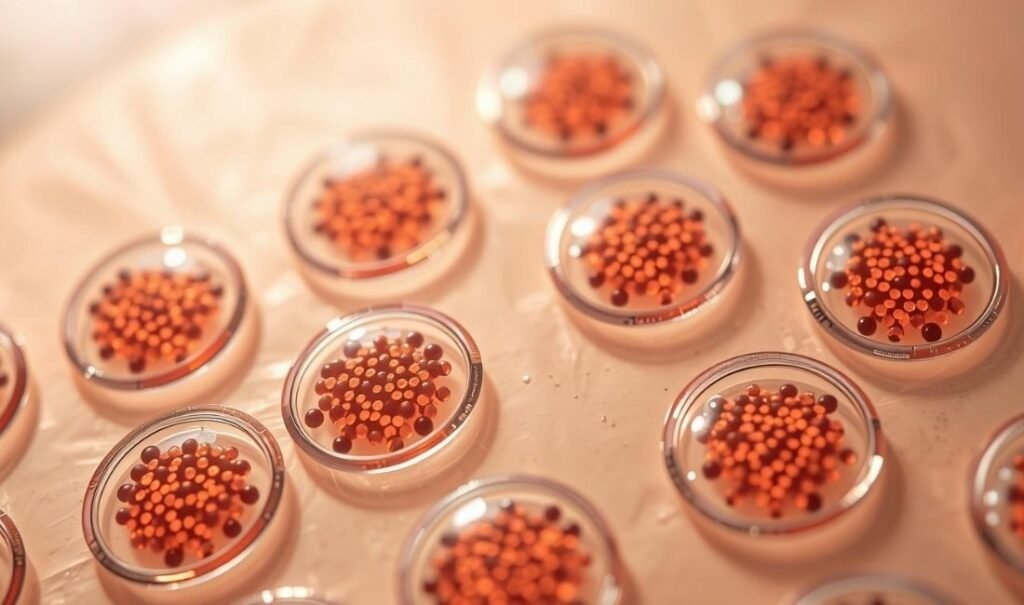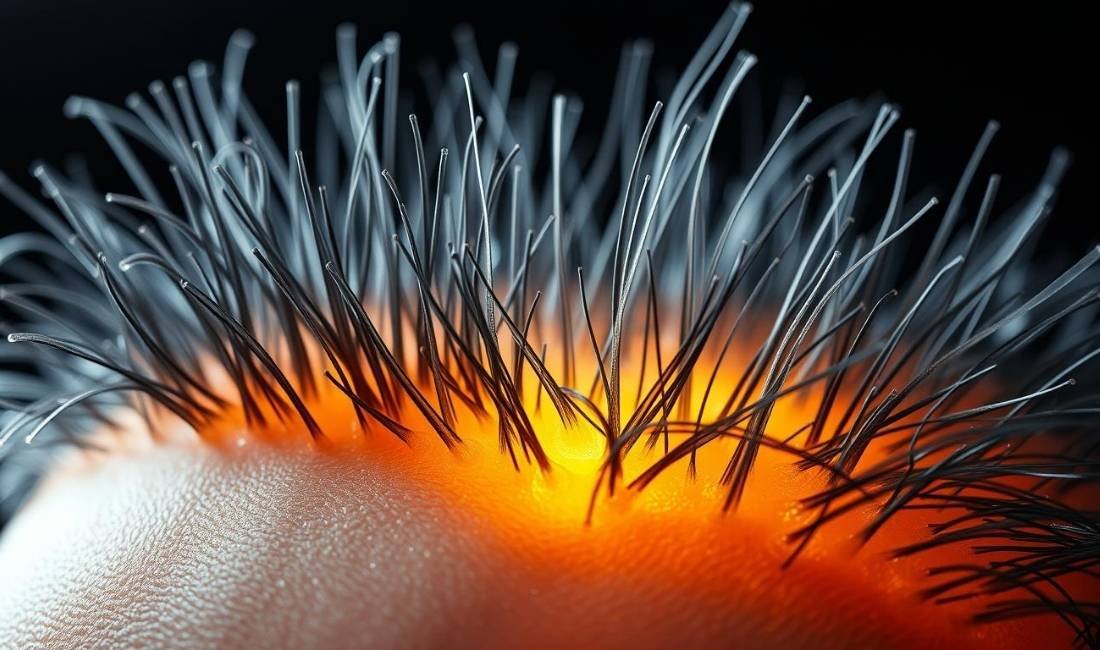Stem cell hair treatment is an advanced, ongoing approach that offers a promising solution for hair loss. Not like traditional transplants, which move existing follicles, this method regenerates new ones using your own stem cells.
A small skin sample is taken, stem cells are cultivated, and then reintroduced into thinning areas to stimulate natural hair growth.
While still under research and not FDA approved, this modern approach may provide a long-term solution. It’s essential to understand the procedure, potential benefits, and risks before considering stem cell hair restoration as a treatment option.
Table of Contents
What Are Stem Cells?
Stem cells are special cells that can differentiate into several kinds of specialized cells throughout the body. These cells are known for their regenerative abilities, meaning they can repair or replace damaged tissues. Stem cells are classified into two main types: embryonic stem cells and adult stem cells.
Embryonic stem cells are pluripotent. It means they can transform into any type of cell in the body. However, their use is controversial due to ethical concerns regarding the source of these cells.
Adult stem cells are found in various tissues throughout the body, including the bone marrow, fat, and skin. They are more specialized than embryonic stem cells but still possess the ability to differentiate into different cell types.
Mesenchymal stem cells, found in fat and bone marrow, are particularly significant in the context of hair restoration as they can regenerate hair follicles.
Recent advancements in stem cell research have focused on harnessing these regenerative properties for treating various conditions, including hair loss. By stimulating hair follicle regeneration, stem cells have the potential to offer a more sustainable and less invasive solution to hair restoration.
What is Stem Cell Hair Treatment?
Stem cell hair treatment is an innovative approach to combating hair loss by utilizing the regenerative power of stem cells to promote hair growth. Unlike traditional hair restoration methods, such as hair transplants or topical treatments like minoxidil, stem cell therapy focuses on regenerating hair follicles rather than relocating existing ones.
The procedure typically involves extracting stem cells from a patient’s own body, most commonly from adipose (fat) tissue or bone marrow, which are rich in mesenchymal stem cells.
These stem cells are then cultured in a laboratory, where they are stimulated to develop into cells that promote hair follicle regeneration. Once ready, the cultured cells are reintroduced into the scalp where hair thinning or bald spots are most prominent.
By using the body’s own stem cells, the treatment reduces the risk of allergic reactions or rejection, making it a safer option for individuals looking to restore their natural hair.
The ultimate goal of stem cell hair treatment is to not only regenerate hair follicles but also to stimulate them into producing new, healthy hair growth in areas affected by thinning or baldness.
Stem Cell Hair Treatment Process of Restoration

One of the top international organizations providing state-of-the-art hair restoration techniques is the Hair Science Institute (HSI). Their approach is based on fundamental research conducted by Coen Gho, who has studied hair transplantation techniques since 1996.
His research discovered that stem cells within different parts of the hair follicle are responsible for stimulating hair growth. This discovery led to the development of stem cell hair treatment, a technique now widely used by HSI.
According to HSI, the following steps make up the painless and successful hair regrowth process:
- Eliminating blood or fat: A little sample is drawn from the patient’s body, typically from blood or fat.
- Isolating stem cells: Stem cells are extracted from the collected sample for further treatment.
- Extracting part of the hair follicle: A small part of the hair follicle is removed while leaving a portion in place, preserving the follicle’s ability to regrow hair.
- Stimulating and duplicating hair follicles: The harvested follicles are cultured and duplicated in a lab to create more follicles.
- Stem cell injection: To promote hair restoration, the patient’s stem cells are injected into pre-existing donor follicles.
- Implanting new follicles: New follicles are inserted into areas of the scalp where hair is thinning or absent, along with stem cells to encourage their growth.
The entire process is relatively painless, and most patients will see long-lasting results after completing one round of treatment. Following the procedure, additional sessions are typically not required.
How Stem Cell Hair Treatment Work
Stem cell hair transplants leverage the regenerative abilities of mesenchymal stem cells to restore hair follicles in areas affected by thinning or baldness.
The process begins by harvesting stem cells from the patient’s own fat tissue or bone marrow, which are cultured in a laboratory to enhance their regenerative properties.
These cultured cells are then carefully injected into the scalp to stimulate both dormant and new hair follicles, encouraging natural hair growth. While the procedure is minimally invasive, it requires several months for noticeable results as the follicles regenerate.
Replicel’s Cell Therapy for Hair Loss
A fascinating biotech company at the forefront of hair loss treatments is Replicel, headquartered in Vancouver, British Columbia. Replicel is developing an autologous cell therapy that utilizes dermal sheath cup (DSC) cells to treat androgenetic alopecia (commonly known as male pattern baldness). This innovative treatment, called RCH-01, is currently preparing to begin its Phase 2 trial, which will enrol 160 male subjects.
In this trial, DSC cells are isolated from a biopsy taken from the patient’s scalp, specifically from the back of the head. After being cultivated in a lab, these cells get injected into the patient’s balding skull.
The trial will track patient progress over a 39-month period, measuring hair volume, density, thickness, and other key metrics to assess the effectiveness of the treatment.
RCH-01 is currently under clinical investigation at Tokyo Medical University Hospital and Toho University Ohashi Medical Centre in Japan. This research is promising, as it could provide a new, highly personalized treatment option for individuals suffering from androgenetic alopecia.
Things to prepare for during Stem Cell Hair Therapy

When you choose stem cell hair treatment, the procedure is simple but involves multiple steps to ensure the best results. The first step is a detailed consultation with a qualified specialist who will assess your scalp, hair loss condition, and overall health.
During this consultation, the doctor will determine whether stem cell therapy is suitable for you and explain the entire process. They will also discuss any pre-treatment preparations, such as avoiding certain medications or lifestyle habits, to ensure the treatment works effectively.
In the Beginning
On the day of the procedure, the specialist will begin by extracting stem cells from your own body, typically from adipose (fat) tissue using a minimally invasive liposuction technique.
In Process
This process is performed under local anaesthesia to ensure comfort, and the extracted stem cells are then taken to a laboratory where they are cultured and stimulated to regenerate hair follicles.
Once the stem cells are ready, they are injected into areas of the scalp that are affected by hair loss. These injections target both dormant hair follicles and areas where new follicles can be regenerated. The injections are carefully placed to stimulate natural hair growth in areas where hair thinning or baldness has occurred.
After Process
After the procedure, you may experience some mild swelling or tenderness on the scalp, but these side effects are typically short-lived. The doctor will provide you with post-treatment care instructions, including advice on scalp care and any necessary medications to help with recovery.
You will need to follow up with your doctor regularly to monitor progress and ensure that the treatment is working as expected.
Results from stem cell hair treatment generally take a few months to become visible. The newly regenerated hair follicles need time to begin producing hair, and full results may not be evident until several months after the procedure. However, with patience and proper aftercare, the results can be a natural and lasting solution to hair loss.
Who is the Ideal Candidate for Stem Cell Hair Treatment?
Stem cell hair treatment is most effective for individuals with early-stage hair loss with active and healthy follicles or mild to moderate baldness. It works best for those with active hair follicles that can be stimulated to regrow.
Candidates should have healthy donor areas, typically from fat tissue or bone marrow, and overall good health to ensure optimal recovery and results.
It may not be suitable for those with extensive hair loss where follicles are completely dormant or damaged. A thorough consultation with a specialist is essential to assess whether stem cell therapy is the right choice based on hair loss severity and individual health factors.
Stem Cell Hair Transplant Side Effects
Like any medical procedure, stem cell hair transplants come with the potential for side effects. Like any medical operation, stem cell hair transplants are typically safe, but there are particular risks to be careful of.
Most of these are mild and temporary, but understanding them is key to managing expectations and ensuring proper recovery. It’s important to follow your doctor’s aftercare instructions to minimize complications.
Following your doctor’s aftercare instructions is important to minimize complications and improve healing.
- The injection place may experience swelling, redness, or pain, although these side effects usually go away in a few days. This is a natural part of the healing process and doesn’t last long.
- Itching or mild bruising on the scalp, especially in areas where stem cells were injected. This is normal and will fade as the scalp heals.
- Infection is a rare occurrence, but it can be prevented with proper hygiene and post-care instructions. Always keep the treated area clean to reduce the risk.
- Scarring at the extraction or injection sites, which is uncommon but can occur with improper technique. Following care instructions can minimize this risk.
- Uneven hair growth during the early stages, as hair follicles regenerate at different rates. This is temporary, and results will become more uniform over time.
- Extended recovery period, with noticeable hair growth appearing within several months. Patience is required as hair follicles take time to regenerate fully.
Is PRP Growth Hair Therapy Similar to Stem Cell Hair Treatment?
While both stem cell hair restoration and Platelet-Rich Plasma (PRP) therapy are popular treatments for hair loss, they differ significantly in their approach and effectiveness. Both methods aim to stimulate hair regrowth, but they utilize different biological components to achieve the desired result.
PRP therapy
PRP therapy involves drawing a small amount of your blood, processing it in a centrifuge to separate the platelets, and then injecting this platelet-rich plasma back into the scalp.
The platelets contain growth factors that are believed to promote hair follicle stimulation and encourage hair regrowth. PRP therapy has been used for hair restoration for several years and is a less invasive procedure compared to traditional hair transplants.
However, its results can vary, and while it shows promising outcomes for many patients, it may not be as effective for advanced stages of hair loss.
Stem Cell Hair Restoration
On the other hand, stem cell hair restoration involves using stem cells, which are harvested from the patient’s body (usually from adipose or bone marrow tissue). These stem cells have the potential to regenerate and repair tissues, including hair follicles, by stimulating the growth of new follicles and rejuvenating dormant ones.
Stem cell therapy may offer a more powerful solution for restoring hair, particularly for individuals with significant hair loss, as stem cells are capable of regenerating multiple types of cells, including those involved in hair growth.
Quick Comparison Table
Here’s a comparison table to highlight the differences between stem cell hair restoration and PRP therapy:
| Feature | Stem Cell Hair Restoration | PRP Therapy |
| Source of Treatment | Uses stem cells from the patient’s own body (fat or bone marrow) | Uses blood-derived platelets from the patient’s own blood |
| Mechanism | Stimulates the regeneration of hair follicles and tissue repair | Stimulates hair follicles through growth factors in platelets |
| Invasiveness | Minimally invasive, requires stem cell extraction | Minimally invasive, requires a blood draw and centrifuging |
| Effectiveness | Often more effective for advanced stages of hair loss | Works best in the early stages of hair thinning |
| Treatment Duration | Multiple sessions may be required for optimal results | Typically, fewer sessions are required |
| Recovery Time | Quick recovery; mild swelling or tenderness may occur | Minimal recovery time, mild swelling or redness possible |
| Side Effects | Rare side effects like infection, scarring | Mild side effects like swelling, bruising, or itching |
| FDA Approval | Not FDA-approved; experimental treatment | FDA-approved for certain medical uses |
Recovery Time and Success Rate of Stem Cell Hair Treatment
Stem cell hair transplants have shown promising results in clinical studies. For instance, an Italian study reported a 29% increase in hair density 23 weeks after the last treatment.
Another study indicated a 27–33% increase in hair density within 23 weeks, with results typically lasting 1–3 years. These findings suggest that stem cell hair transplants can be effective for individuals experiencing hair thinning or early-stage hair loss.
Recovery time for stem cell hair treatment is generally shorter compared to traditional hair transplants. Patients may experience mild swelling or tenderness at the injection sites, but these symptoms typically resolve within a few days.
Most individuals can return to their normal activities within a week. However, full results may take several months to become apparent, as hair follicles need time to regenerate and produce new hair.
It’s important to note that while these treatments offer significant benefits, they are not FDA-approved and are considered experimental. Patients should consult with qualified specialists to understand the potential risks and benefits before proceeding with stem cell hair therapy.
Stem Cell Controversy and Cost: What to Know
Stem cell hair restoration, while promising, is not without its controversies. One of the primary concerns is the lack of FDA approval for these procedures.
As of now, stem cell-based hair treatments are considered investigational and are not approved by the U.S. Food and Drug Administration for cosmetic or aesthetic uses. This means that their safety and efficacy have not been conclusively established through large-scale, peer-reviewed clinical trials.
Additionally, the ethical implications of stem cell therapies are a topic of ongoing debate. Modern stem cell therapies often utilize induced pluripotent stem cells (iPSCs) or mesenchymal stem cells (MSCs).
Which are derived from adult tissues and do not involve the use of embryos, concerns remain regarding the potential for tumorigenesis (the formation of tumours) and malignant transformation of these cells.
Another issue is the regulation of stem cell clinics. Some clinics offer stem cell hair restoration treatments without proper oversight, leading to concerns about patient safety, misleading marketing practices, and the potential for unproven or ineffective treatments being administered.
The cost of a stem cell transplant for hair is also variable, as research is still ongoing. Several investigational clinics offer services ranging from $3,000 to $10,000. However, the final cost may still depend on the hair loss type and the extent of treatment
Final Thoughts on Stem Cells for Hair Treatment
Stem cell hair treatment offers a promising alternative to traditional hair transplants by harnessing the body’s regenerative potential to stimulate natural hair growth.
While the treatment shows significant potential, it is still in the investigational stage, and its long-term effectiveness remains under evaluation.
The lack of FDA approval and the ethical, regulatory, and cost-related concerns add layers of complexity to the decision-making process for individuals considering this option.
For those in the early stages of hair loss, stem cell therapy may provide a viable solution, but it is essential to consult with qualified specialists to fully understand the risks, benefits, and costs involved.
As research advances, the future of stem cell hair treatments may offer more accessible and effective solutions, potentially changing hair restoration practices. However, patience and careful consideration are crucial before embarking on this treatment path.
Frequently Asked Questions
1. How long does a stem cell hair transplant take?
The procedure typically takes several hours to complete, depending on the size of the treatment area. Most patients can expect the entire process to take 4 to 6 hours, with breaks in between.
2. Are stem cell hair transplants painful?
The procedure is generally painless as local anesthesia is used to numb the scalp during both stem cell extraction and follicle injection. Some mild discomfort or tenderness may occur after the procedure, but it typically resolves within a few days.
3. How many sessions will I need?
Most patients experience significant improvements after one session. However, the number of sessions required depends on the extent of hair loss and the individual’s response to the treatment.
4. Is Stem Cell Hair Treatment Safe?
Stem cell hair treatment is generally considered safe when performed by a qualified specialist. Since the procedure uses your stem cells, the risk of rejection or allergic reactions is minimal. However, as with any medical procedure, there may be potential side effects such as mild swelling or temporary tenderness, which typically subside within a few days.
5. How Long Does It Take to See Results from Stem Cell Hair Treatment?
Results from stem cell hair treatment vary by individual. Typically, it takes 3 to 6 months to start noticing visible hair regrowth. Patience is key for optimal outcomes.

